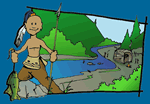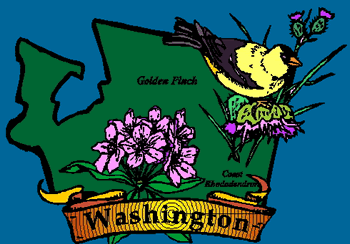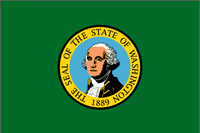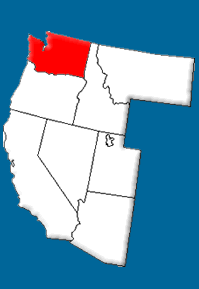 History:
In the mid-1700s, two groups of explorers and settlers converged on the area that is now Washington. First, Russian fur traders had crossed the Bering Strait and began to settle in the area we now know as Alaska. Meanwhile, Spanish explorers led by Bruno Heceta came north from California. They landed near present-day Point Grenville in 1775 and claimed the Washington region for Spain. Spain continued to explore Washington in an attempt to prevent Russian traders from claiming land further south than Alaska.
About twenty years later, George Vancouver explored most of the Washington coast and Puget Sound and claimed the land for England. Other British explorers came into Washington from Canada in the early 1800s. However, in 1792, the new nation of the United States also began to lay claim to parts of Washington, as Robert Gray explored the Columbia River. By 1805, Meriwether Lewis and William Clark had arrived in the area as part of their exploration of the Louisiana Purchase and further strengthened the claim by the U.S.
The most important attraction for these early explorers was the lucrative fur trade, particularly the fur of the sea otter. In 1810, a trading post was established near Spokane. In 1811, John Jacob Astor funded Fort Okanogan, the first permanent American settlement in Washington. After the War of 1812, the U.S. and England agreed, in 1818, that settlers from both countries could move into Washington, which was still officially part of the Oregon Country. In 1825, John McLoughlin of the British Hudson's Bay Company established Fort Vancouver.
In 1846, Great Britain and the United States signed a treaty that established the 49th parallel as the border between the United States and Canada, making Washington officially part of the U.S. By 1850, more than 1,000 people had settled in Washington, and Washington Territory was established as a separate area from the Oregon Country in 1853.
The first territorial governor, Isaac I. Stevens, wanted to settle territorial disputes with the Native American inhabitants of the area, and to improve transportation in the area. Stevens negotiated treaties with the Indians in 1855, but the treaties did not really settle anything, and there was intermittent conflict and violence between settlers and Indians for the next three years. This conflict delayed construction on the northern part of the transcontinental railway. In 1858, the Indians in the area surrendered at Four Lakes, and agreed to move onto reservations, and the 1860s brought thousands of new settlers to the area as gold was discovered in the surrounding areas of Idaho, Oregon and British Columbia. No significant deposits of gold were ever discovered in Washington, but many settlers remained to farm or to work in logging camps. By 1883, the railroad finally connected Washington with the East, and more settlers followed. Washington became the 42nd state in 1889.
Increased irrigation during the 1890s brought more farmers to Washington to plan fruit orchards and wheat fields. Railroad expansion allowed the coastal cities to become important port centers. |









